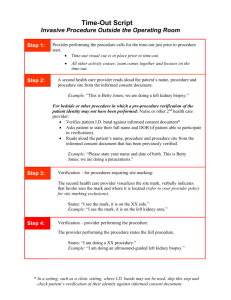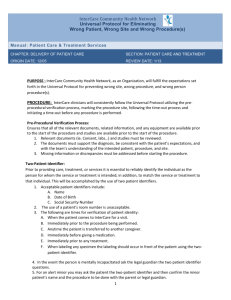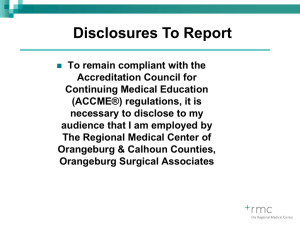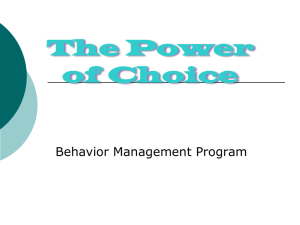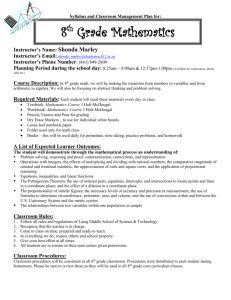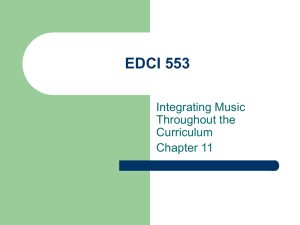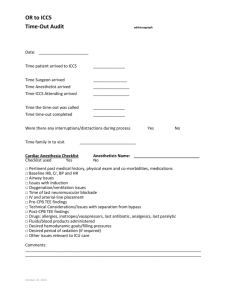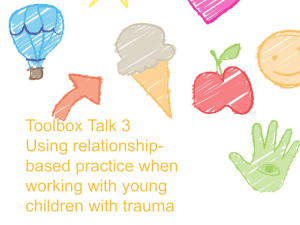TIME-OUT INTERVENTIONS AND STRATEGIES
advertisement
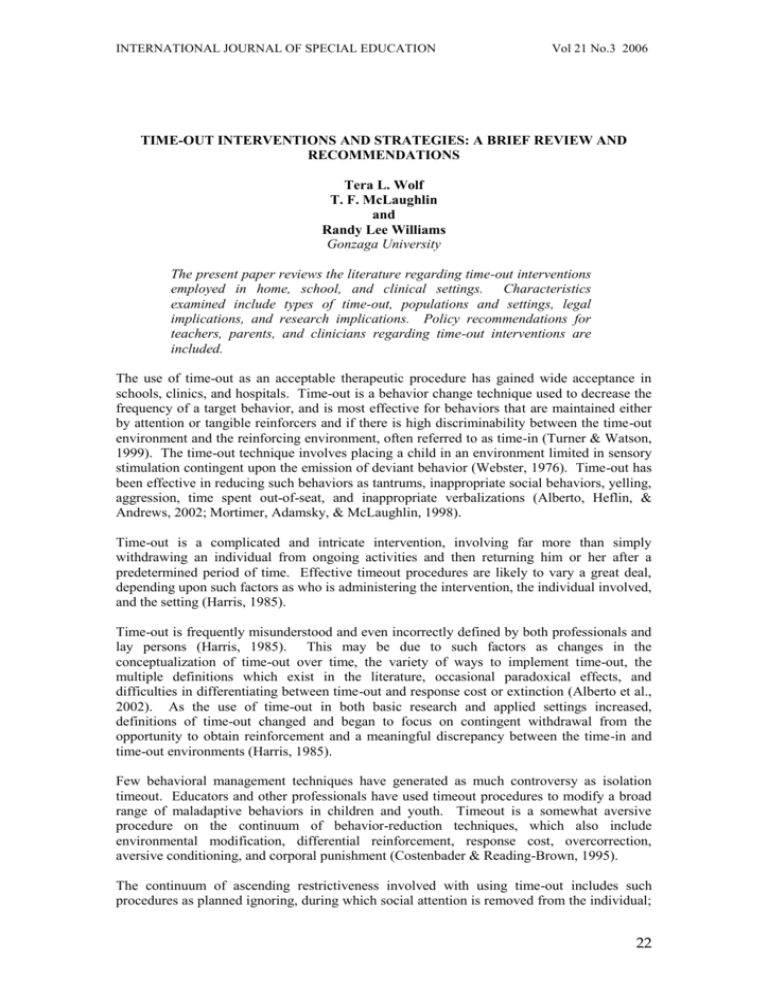
INTERNATIONAL JOURNAL OF SPECIAL EDUCATION Vol 21 No.3 2006 TIME-OUT INTERVENTIONS AND STRATEGIES: A BRIEF REVIEW AND RECOMMENDATIONS Tera L. Wolf T. F. McLaughlin and Randy Lee Williams Gonzaga University The present paper reviews the literature regarding time-out interventions employed in home, school, and clinical settings. Characteristics examined include types of time-out, populations and settings, legal implications, and research implications. Policy recommendations for teachers, parents, and clinicians regarding time-out interventions are included. The use of time-out as an acceptable therapeutic procedure has gained wide acceptance in schools, clinics, and hospitals. Time-out is a behavior change technique used to decrease the frequency of a target behavior, and is most effective for behaviors that are maintained either by attention or tangible reinforcers and if there is high discriminability between the time-out environment and the reinforcing environment, often referred to as time-in (Turner & Watson, 1999). The time-out technique involves placing a child in an environment limited in sensory stimulation contingent upon the emission of deviant behavior (Webster, 1976). Time-out has been effective in reducing such behaviors as tantrums, inappropriate social behaviors, yelling, aggression, time spent out-of-seat, and inappropriate verbalizations (Alberto, Heflin, & Andrews, 2002; Mortimer, Adamsky, & McLaughlin, 1998). Time-out is a complicated and intricate intervention, involving far more than simply withdrawing an individual from ongoing activities and then returning him or her after a predetermined period of time. Effective timeout procedures are likely to vary a great deal, depending upon such factors as who is administering the intervention, the individual involved, and the setting (Harris, 1985). Time-out is frequently misunderstood and even incorrectly defined by both professionals and lay persons (Harris, 1985). This may be due to such factors as changes in the conceptualization of time-out over time, the variety of ways to implement time-out, the multiple definitions which exist in the literature, occasional paradoxical effects, and difficulties in differentiating between time-out and response cost or extinction (Alberto et al., 2002). As the use of time-out in both basic research and applied settings increased, definitions of time-out changed and began to focus on contingent withdrawal from the opportunity to obtain reinforcement and a meaningful discrepancy between the time-in and time-out environments (Harris, 1985). Few behavioral management techniques have generated as much controversy as isolation timeout. Educators and other professionals have used timeout procedures to modify a broad range of maladaptive behaviors in children and youth. Timeout is a somewhat aversive procedure on the continuum of behavior-reduction techniques, which also include environmental modification, differential reinforcement, response cost, overcorrection, aversive conditioning, and corporal punishment (Costenbader & Reading-Brown, 1995). The continuum of ascending restrictiveness involved with using time-out includes such procedures as planned ignoring, during which social attention is removed from the individual; 22 INTERNATIONAL JOURNAL OF SPECIAL EDUCATION Vol 21 No.3 2006 contingent observation, where a student watches from the periphery but may not participate in group activities during the timeout period; exclusion timeout, when a student is removed from the reinforcing environment but may sit facing the corner of the room; and isolation or seclusion timeout, the most restrictive of these interventions, in which the student is removed from the classroom and stays alone in a barren room for a specified period of time. Types of Time-Out Harris (1985) outlined three major types of time-out: exclusionary, non-exclusionary, and isolation time-out. Of these three, the first two types seem best suited for classroom use because the child does not need to be removed from the room (in accordance with the policy of least restrictive intervention). Exclusionary. Exclusionary time-out involves removing the child from the reinforcing situation but not from the room or area of activity (e.g., playground, gym). When a child displays the inappropriate target behavior, he or she is immediately removed from the activity for a period of time. Examples of this type of time-out are sending a child to a corner of the room or a chair positioned away from the ongoing activity. The child is not allowed to view or be involved in any activity for a specified amount of time (Harris, 1985; Mace & Heller, 1990; Mortimer et al., 1998). Nonexclusinoary. Nonexclusion time-out is similar to exclusion time-out in that the child is removed from the reinforcing situation for a certain amount of time but may still observe the ongoing activity of the class (Harris, 1985). Nonexclusinoary time-out has been further divided into three subcategories: contingent observation, removal of stimulus conditions, and ignoring (Costenbader & Reading-Brown, 1995; Harris, 1985). Harris (1985) defines the first subcategory, contingent observation, as a procedure wherin the individual is required to sit on the periphery of the ongoing activity and observe the appropriate behaviors of her or his peers for a brief period of time (p.280). This type of time-out would be ideal during some activity such as recess or a structured group academic task in which the child can observe appropriate peer behaviors and see those behaviors being reinforced. To make contingent observation time-out most effective, the teacher must reinforce appropriate behaviors and the resulting reinforcement (Turner & Watson, 1999). After time-out is over, the teacher must then monitor the child to reinforce the first appropriate behavior demonstrated by the target child to ensure a rich time-in environment and to increase the discriminability between time-out and the classroom (Marlow, Tingstrom, Olmi, & Edwards, 1997). The second subcategory of non exclusionary time-out, removal of stimulus conditions, imposes the contingent removal of reinforcing stimuli such as work or play materials, food, or opportunity to gain tokens (Alberto et al., 2002; Harris, 1985) for a certain amount of time after target behaviors are displayed. The reintroduction of reinforcing stimuli should be contingent upon demonstrating appropriate behavior to avoid inadvertently reinforcing inappropriate behavior (Harris, 1985). The third category of nonexclusionary time-out, ignoring, involves withholding social attention contingent upon inappropriate behavior without removing the child from the situation (Turner & Watson, 1999). Ignoring is difficult to use in the classroom for three primary reasons: (a) some behaviors annoy, distract, or interfere with instruction to such an extent that they are almost impossible to ignore, (b) peer attention may maintain or contribute to the maintenance of a behavior, and (c) some behaviors are dangerous to the student and others (Turner & Watson, 1999). However, ignoring a child’s misbehavior is a simple procedure and can be quite effective given the proper circumstances (i.e., for a behavior that is mildly annoying, maintained solely by teacher attention, does not evoke attention from peers, and is not dangerous or destructive). 23 INTERNATIONAL JOURNAL OF SPECIAL EDUCATION Vol 21 No.3 2006 Isolationary. The third broad category of time-out is referred to as isolation. Isolation involves the removal of the child from the reinforcing environment to an environment where, at least theoretically, there are no reinforcers available to the child (Tingstrom, 1990). Isolation typically entails placing the student in a different area such as another room for a specified amount of time. As effective as this type of time-out can be (Costenbader & Reading-Brown, 1995), isolation requires extra personnel, (Harris, 1985), has specific federal, state, and local guidelines for its use (Yell, 1990), and is generally regarded as a more restrictive form of punishment (Mayerson, 2003). Because of these reasons, it may be difficult to use isolation in the standard classroom. Use of isolation time-out should b determined by criteria which include the chronicity and intensity of the behavior, the danger of the behavior to those in the classroom, and the effectiveness of other techniques to change the behavior (Tingstrom, 1990). It should be then implemented only if the specific state and local legal prerequisites have been met (Yell, 1990). Populations and Settings Proponents of using time-out with young children extol its virtues, at least for children two or three years of age and older (Readdick & Chapman, 2000). Numerous studies (Rortvedt & Miltenberger, 1994; Mace & Heller, 1990; Wilson, Robertson, Herlong, & Haynes, 1979; Alberto et al., 2002, Reitman & Drabman, 1996; Yeager & McLaughlin, 1995) have shown various effective uses of time-out with preadolescent children in the home, schools, and treatment facilities. A study of Reitman and Drabman (1999) illustrates how the ongoing data-based monitoring of timeout use by parents enhanced the treatment of an 8-year-old boy, referred because of noncompliance in the home. Timeout was selected as the primary behavior change strategy and parents were instructed in implementing and recording each instance of timeout on a simple data form. In therapy sessions these data were reviewed and used to direct the course of treatment. Some of the benefits of the timeout record included, enabling rapid refinements in the timeout procedure by providing a feedback mechanism to the therapist, illustrating the need for adjunctive treatments and revision of case formulation, and more generally, by serving as a means of documenting treatment efficacy. Numerous studies have evaluated the use of time-out in classroom and school environments in the areas of aggression (Lucas, 2000; Mortimer et al., 1998; Wilson, et al., 1979; Webster, 1976) and disruptive and noncompliant behavior (Mace & Heller, 1990;; Mace, Page, Ivancic & O’Brien, 1986; Rortvedt & Miltenberger, 1994; Reitman & Drabman, 1996; Yeager & McLaughlin, 1995;). The use of time-out has also been implemented in academic settings of community-based instruction (CBI) (Alberto et al., 2002), speech and language classrooms (Marrow et al., 1997), music education (Spradling, 1985), and physical education (Johnson, 1999; White & Bailey, 1990;). Whittington and Moran (1990) evaluated Peace begins with me (Whittington, Crites, Kreidman, Beck, 1989 cited in Whington & Moran 1990), a published prevention curriculum for use with kindergarten through sixth-grade children. Time out was viewed as an efficient means of providing space and time for the young child to mull over wrongdoings, refresh feelings of guilt, and ponder socially desirable responses in similar circumstances. The curriculum offers keys to attitude and behavior changes as these relate to self-esteem and self control. Children lean nonviolence and a foundation for basic coping skills and positive mental health. They integrate time-out, self-talk, empathy, gender-neutral attitudes, feelings awareness, assertiveness, conflict resolution, health, parent appreciation, and other concepts as personal tools for daily survival. Lesson topics must be adapted to the developmental levels of children. The use of time out appears to be widespread however, preschool teachers 24 INTERNATIONAL JOURNAL OF SPECIAL EDUCATION Vol 21 No.3 2006 often use time-out frequently throughout the day, but for very short durations, often on or two minutes (Zabel, 1986). Incidentally, Betz (1994) believes that there are right and wrong ways to enforce time-outs. Some ways to make time-out for young children more effective according to Betz is to first approach the child physically rather than broadcasting displeasure in behavior from across the room. Second, a teacher should get down on a knee so that eye levels of student and teacher are level and tell the child exactly what the offense is quietly and calmly. Third, the teacher should escort the child to the time-out area and keep the time-out duration short; the suggested limit is about one minute per year of age. Finally, the teacher should not forget about the child in time-out, otherwise the effectiveness of the time-out could be jeopardized. Gartrell (2001) believes that time-out, when used as discipline, is one of a group of techniques that still rely on blame and shame to bring a child’s behavior back into line. Referring especially to toddlers, Gartrell offers five reasons why time-out is an undesirable practice: (1) the imposed external control of the time-out inhibits a child’s ability to build internal controls and may cause a child last feelings of being ineffectual, (2) the child placed on a time-out chair does not have personal needs met, including the need to develop alternative strategies, (3) the time-out diminishes the child’s developing self-worth and self-confidence, and may cause others to view the child as a trouble maker, (4) the young child has difficulty understanding the relation of actions to consequences and may feel bewildered by the timeout experience, and (5) opportunities for learning valuable lessons in social relationships are lost during the period of isolation; and humiliation from the time-out may diminish the value of adult follow-up. Bezt (1994) emphasizes that time-out fails to teach desirable behavior and should be reserved for use only when a child is wildly out of control or is a threat to other children. There is speculation that time-out may be hurtful in a number of ways. Readdick and Chapman (2000) point out that if the child perceives it as a punishment, time-out can have serious side effects that are commonly associated with punishment, including increases of other maladaptive behaviors and withdrawal from or avoidance of the adults administering time-out. In addition, given their social inexperience, young children ten to internalize negative labels, see themselves as they are labeled, and react accordingly (Readdick & Chapman, 2000). Furthermore, Harris (1985) points out that when procedural time-out is experienced as an aversive consequence by the subject and results in reduction or suppression of the target behavior, then time-out is properly classified as a punisher. In fact, time-out is typically defined or classified as a punishment procedure based on the assumption that it will be experienced as aversive by the subject and reduce the frequency of a behavior. Harris describes how time-out may function as a negative reinforcer or escape procedure even when a validated reinforcement procedure exists in the time-in environment. Hannon (2000), a kindergarten teacher who decided against using time-out after years of incorporating this technique in her classroom states that, not relying on time out has been both frightening and a relief…belatedly, I have realized and deeply regret how much time was wasted in time-out by children misled by my lack of clarity. I see now how important it is that I discuss and model my expectations for appropriate behavior with children. Many of the children benefit from well-timed and clear discussions or demonstrations concerning developmentally appropriate behavior. When we have a bad day, the fault is often due to inappropriate expectations or insufficient preparation on my part (p. 113). The use of time-out procedures is a topic of major importance to teachers of behaviorally disordered students. A survey of special education teachers (Zabel, 1986) identified variables associated with use of time-out. Among those variables were restrictiveness of placement and age of child. Teachers or self-contained special educational classrooms reported using time- 25 INTERNATIONAL JOURNAL OF SPECIAL EDUCATION Vol 21 No.3 2006 out more frequently than did teachers of resource rooms. Teachers of younger children reported using the technique more frequently than did teachers of older children and youth. Respondents to Zabel’s survey reported that they used the time-out procedure about five times per week and that, on average, each child remained in time-out for 12 min. Verbal and physical aggression were the two behaviors most frequently reported to result in time-out. About half of respondents reported that they kept a log of their use of time-out, and less than a quarter of the sample reported that their school districts had written guidelines for the use of time-out procedures. Zabel (1986) discusses the use of time-out intervention as appearing to lessen as students get older, perhaps because teachers have more sophisticated, language-based interventions for use with older students. Also, as students get older, the question of physical persuasion for those who might refuse to go to time-out must be considered in light of both possibility and appropriateness. However, a study by Costenbader and Reading-Brown (1995) which investigated the use of isolation time-out in a special education facility administered by a consortium of 26 rural school districts in upstate New York found that older students comprised the majority of students in time-out. All students were classified as emotionally disturbed (ED) by their home school districts, and all students received 100% of their education in special classes. Students were placed in this facility by their home school districts only after less restrictive intervention strategies for controlling behaviors had been tried and failed. This facility represented the most restrictive school-based placement in the six-county area. Students in this special education facility were divided into a Lower School, consisting of grades K-6, and an Upper School, consisting of grades 7-12. Information used in the study was taken from computer data routinely gathered to monitor the use of isolation time-out rooms in the special education facility over one academic year. Three infractions-talking, failure to follow directions, and students electing to take a voluntary time-out period accounted for 70% of all incidents. Only 1% of all time-outs were reportedly caused by aggressive physical conduct. In 1986, Zabel found that younger students experienced the time-out procedure more frequently than did older students. In contrast, Costenbader and Reading-Brown (1995) found that older students in the more restrictive placement are spending more time in time-out for more separate behavioral incidents than are younger students. The differential use of voluntary timeout best accounts for this. Although 22% of the timeouts experienced by older students were voluntary, less than 1% of those taken by younger students were selfdetermined. Undoubtedly, a number of these behavioral incidents would have escalated from voluntary to teacher-assigned timeout had the student not chosen to separate himself or herself from the classroom. Legal Implications of Time Out The use of behavior reduction procedures, such as timeout, with students with BD has been an area that has spawned a great deal of debate. Although the Individuals with Disabilities Education Act (IDEA), Section 504 of the Rehabilitation Act of 1973, and regulations implementing these laws are quite detailed, there are no specific guidelines as to the use of the behavior reduction procedures (Yell, 1994). Yell points out that the resulting lack of guidelines has led to uncertainty among special education administrators and teachers as to the legally sound use of these procedures. Frequently, when federal laws and regulations do not exist, it falls upon the courts to become arbiters, acting to balance competing interests through an interpretation of existing laws. The courts, in interpreting existing laws, fashion a body of law known as case law. The lack of federal guidelines has resulted in a fair amount of case law regarding behavior reduction 26 INTERNATIONAL JOURNAL OF SPECIAL EDUCATION Vol 21 No.3 2006 procedures. The procedures that have most frequently been the subject of litigation are the suspension and expulsion of children with disabilities. Timeout has also been the subject of litigation. A small body of case law has been developing regarding the use of timeout procedures with students with behavioral disorders. Yell (1994) analyzed a number of cases on the use of behavior reduction procedures with students in special education and concluded that timeout is a controlled intervention. That is, timeout is legally permissible is used correctly. However, misuse of controlled interventions could result in rulings against school districts. This is particularly true in cases involving the use of seclusion/isolation timeout. In such cases school districts may be liable for large attorney’s fees awards. Thus it is extremely important that teachers be aware of legal considerations in the use of timeout. Four federal court cases have dealt with the use of timeout with students with BD. These cases involved teachers using timeout procedures with special education students. In their decisions, the court’s discussed guidelines and procedures that should be followed in using timeout. Three of these cases-Cole v. Greenfield-Central Community Schools (1986), Dickens v. Johnson County Board of Education (1987), and Hayes v. Unified School District No. 377 (1989) directly addressed the use of timeout procedures (Yell, 1994). The fourth case, Honig v. Doe (1988), concerned the use of suspension and expulsion but briefly mentioned timeout when offering guidelines to school districts using behavior reduction procedures with students in special education. All of these court cases have involved law suits brought by parents against teachers, principals, and school districts that used exclusion and seclusion/isolation timeout or similar procedures to reduce the undesirable behaviors of students with BD. Most abuses occur, experts say, when educators don’t understand the purpose of timeout, or overuse it (Lang, 1997). Intended only as a temporary measure, timeout quickly becomes ineffective and even dangerous when children are placed in small, enclosed places for long periods of time. In Georgia, the Thomaston case is one of several reported uses of cardboard boxes for school discipline, said Denise Freeman, a spokesman for Citizens United for Rural Empowerment, an educational clearinghouse based in Tignall, Ga. (Lang, 1997). Students have also been placed in broom closets, locked rooms, or plywood boxes designed specifically for timeout. Research Implications Although time-out is frequently used by teachers, researchers and practitioners, it has become a controversial procedure because of misunderstanding, ineffective use, and ethical considerations. Regardless of the type of time-out used, it is the discrepancy between the time-in and time-out environments that provides the conceptual basis for time-out. When time-out is determined to be the intervention of choice, the least restrictive and aversive procedure likely to be effective should be designed on an individualized basis. Constructing such procedures, however, depends a great deal on professional judgment due to the scarcity of parametric studies. Research comparing time-out and alternative interventions is also scarce, although effective alternatives to time-out have been documented (Harris, 1985; Gartrell, 2001; Betz, 1994; Hannon, 2002; Lang, 1997 Pica & Howard, 1993). Parametric and comparative research is requisite to the development of a comprehensive knowledge base concerning time-out interventions (Harris, 1985). Careful documentation of time-out procedures as well as both positive and negative results is also essential. Since timeout continues to be widely used, these issues must be addressed by researchers and practitioners. References Alberto, P., Heflin, L.J., & Andrews, D. (2002). Use of the timeout ribbon procedure during community-based instruction. Behavior Modification, 26, 297-11. Betz, C. (1994). Beyond time-out: Tips from a teacher. Young children, 49, 10. 27 INTERNATIONAL JOURNAL OF SPECIAL EDUCATION Vol 21 No.3 2006 Costenbader, V.K., & Reading-Brown, M. (1995). Isolation timeout used with students with emotional disturbance. Exceptional Children, 61, 353-363. Gartrell, D. (2001). Replacing time-out: part one—Using guidance to build an encouraging classroom. Young Children, 56, 8-16. Hannon, J. (2002). No time for time out. Kappa Delta Pi Record, 38, 112-4. Harris, K. R. (1985). Definitional, parametric, and procedural considerations in timeout interventions and research. Exceptional Children, 51, 279-288. Johnson, R. (1999). Time-out: Can it control misbehavior? Journal of Physical Education, Recreation and Dance, 70, 32-46. Lang, L. (1997). Often effective, timeout target in abuse cases. Education Week, 16, 1. Lang, L. (1997). Too much timeout. Teacher Magazine, 8, 6-7. Lucas, R.L. (2000). The effects of time-out and DRA on the aggressive behavior of a spirited two-year-old. Child and Family Behavior Therapy, 22, 51-56. Mace, F. C., & Heller, M. (1990). A comparison of exclusion time-out and contingent observation for reducing severe disruptive behavior in a 7-year-old boy. Child & Family Behavior Therapy, 12, 57-68. Mace, F. C., Page, T. J., Ivancic, M.T., & O’Brien, S. (1986). Effectiveness of brief time-out with and without contingent delay: A comparative analysis. Journal of Applied Behavior Analysis, 19, 79-86. Marlow, A.G., Tingstrom, D.H., Olmi, D.J., & Edwards, R.P. (1997). The effects of classroom-based time-in/time-out on compliance rates in children with speech/language disabilities. Child and Family Behavior Therapy, 19, 1-13. Mayerson, A.B. (2003). Should we eliminate time-out rooms? Educate children, don’t imprison them. American Teacher, 87, 4. Mortimer, S., Adamsky, S., & McLaughlin, T. F. (1998). Use of isolated time out to reduce aggression and non-compliance with an elementary school student with severe behavior disorders: A long term analysis. International Journal of Special Education, 13(1), 34-45. Pica, L., Jr., & Margolis, H. (1993). What to do when behavior modification is not working. Preventing School Failure, 37, 29-33. Readdick, C. A., & Chapman, P. L. (2001). Young children’s perceptions of time out. Journal of Research in Childhood Education, 15, 81-87. Reitman, D., & Drabman, R. S. (1996). Read my fingertips: A procedure for enhancing the effectiveness of time-out with argumentative children. Child & Family Behavior Therapy, 18, 35-40. Reitman, D., & Drabman, R. S. (1999). Multifaceted uses of a simple timeout record in the treatment of a noncompliant 8-year-old boy. Education and Treatment of Children Special Issue: Level 1 research: Improving our education and treatment through simple accountability procedures, 22, 136-145. Riley, K. (2003). Should we eliminate time-out rooms? Used wisely, they can help students. American Teacher, 87, 4. Rortvedt, A. K., & Miltenberger, R. G. (1994). Analysis of a high-probability instructional sequence and time-out in the treatment of child noncompliance. Journal of Applied Behavior Analysis, 27, 327-30. Spradling, R. L. (1985). The effect of timeout from performance on attentiveness and attitude of university band students. Journal of Research in Music Education, 33, 123-137. Tingstrom, D.H. (1990). Acceptability of time-out: The influence of problem behavior severity, interventionist, and reported effectiveness. Journal of School Psychology, 28, 165169. Turner, H. S., & Watson, T. S. (1999). Consultant’s guide for the use of time-out in the preschool and elementary classroom. Psychology in the Schools, 36, 135-148. Webster, R. E. (1976). A time-out procedure in a public school setting. Psychology in the Schools, 13, 72-76. White, A. G., & Bailey, J. S. (1990). Reducing disruptive behaviors of elementary physical education students with sit and watch. Journal of Applied Behavior Analysis, 23, 353-59. 28 INTERNATIONAL JOURNAL OF SPECIAL EDUCATION Vol 21 No.3 2006 Whittington, R., & Moran, G. (1990). Teaching nonviolence through time out: A curriculum for elementary school classrooms. Social Work in Education, 12, 237-248. Wilson, C.C., Robertson, S.J., Herlong, L.H., & Haynes, S.N. (1979). Vicarious effects of time-out in the modification of aggression in the classroom. Behavior Modification, 3, 97111. Yeager, C., & McLaughlin, T.F. (1995). Use of a time-out ribbon and precision requests to improve child compliance in the classroom: A case study. Child & Family Behavior Therapy, 17, 1-9. Yell, M.L. (1990). The use of corporal punishment, suspension, expulsion, and timeout with behaviorally disordered students in public schools: Legal considerations. Behavioral Disorders, 15, 100-109. Yell, M.L. (1994). Timeout and students with behavior disorders: A legal analysis. Education and Treatment of Children, 17, 293-301. Zabel, M.K. (1986). Timeout use with behaviorally disordered students. Behavioral Disorders, 12, 15-21. 29
